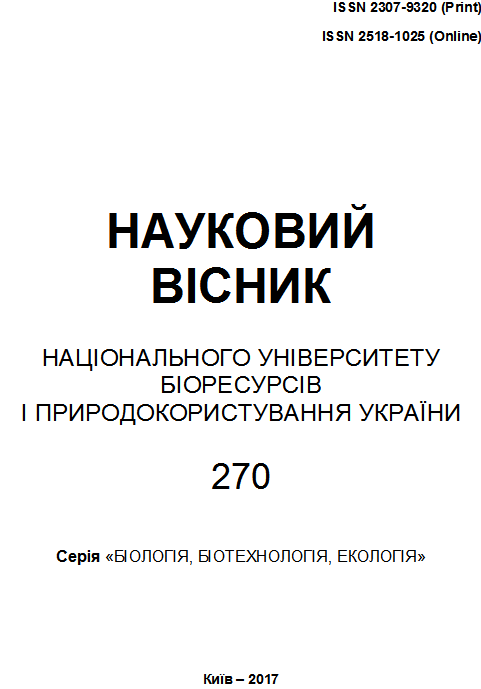PHOTORECEPTOR’S SYSTEM AS MARKERS ORIENTATION FOR HORSE-CHESTNUT LEAF MINER IN SPACE
Abstract
There were focused aspects of biology horse-chestnut leaf miner (HCLM), including search, selection of plants-hosts, insects breadwinner and orientation in space.
HCLM is one of the most dangerous, aggressive and alien species spread, which is characterized by the presence of sufficient fodder, lack of natural predators and high speed resettlement area causing dehydration, yellowing, leaf drying infection and premature death of common horse-chestnut plants (Aesculus hippocastanum L.) in vivo growth, especially in settlements. For the first time, the presence of the facet complex structure of HCLM eye lens, which is located symmetrically on the sides of the head, and the long, cylindrical light-omatidiums. It is shown that for typical butterflies HCLM free orientation in space, which is a sign of the integral brain. Such brain makes the cooperation for multimodal sensory information and made motions involving significant memory resources.
References
http://www.hantsmonths.org.uk/species/0366a.php.
Akimov, I. A., Zerova, M. D., Narol’skiy, N. B. i dr. (2006). Biologiya kashtanovoy miniruyushchey moli – Cameraria ohridella Deschka et Dimić (Lepidoptera: Glacillariіdea) v Ukrainі [Horse-chestnut leaf miner`s biology - Cameraria ohridella Deschka et Dimić (Lepidoptera: Glacillariіdea) in Ukraine]. Herald of zoology, 40 (4), 321 – 332.
Trybel’, S. O., Gamanova, O. M., Svjentoslavski, Ja. (2008). Kashtanova minujucha mil’ [Horse-chestnut leaf miner]. Kolobig,72.
Zerova, M. D., Nikitenko, G. N., Narol’skiy, N. B. i dr. (2007). Kashtanovaya miniruyushchaya mol’ v Ukraine [Horse-chestnut leaf miner in Ukraine]. Ltd. Veles, 87.
Chajka, V. M., Grygorjuk, I. P., Mel’nychuk, M. D. (2013). Ekologija agroekosystem Ukrai’ny v umovah zmin klimatu [Ecology of Ukraine agro-ecosystems in a changing climate]. CP Komprynt, 628.
Popov, G.V., Sviridov, S. V. (2009). Kashtanovaya mol’ i bor’ba s ney v Donetskoy oblasti [Horse-chestnut leaf miner and fighting with it in the Donetsk region]. Donetsk, 20.
Grygorjuk, I. P., Luk’janenko, T. L. (2015). Fiziologichni i molekuljarni osnovy stijkosti vydiv roslyn rodu Aesculus L. proty kashtanovoi’ minujuchoi’ moli [Physiological and molecular basis of the stability of plant genus Aesculus L. against horse-chestnut leaf miner]. CP Komprynt,174.
Zakhvatkin, Yu. A. (2001). Kurs obshchey entomologii [General Entomology Course]. Moscow, Russia: Kolos, 376.
Ross, G., Ross, Ch., Ross, D. (1985). Entomologiya [Entomology]. Moscow, Russia: Peace, 576.
Posudin, Ju. I. (2011). Biofizyka i metody analizu navkolyshn’ogo seredovyshha: Pidruchnyk [Biophysics and methods of analysis of the environment: Textbook]. NULES publishing center, 296.
Bey-Bienko G. Ya. (1980). Obshchaya entomologiya [General Entomology]. Moscow, Russia: Higher education, 416.
Shvanvich, B. N. (1949). Kurs obshchey entomologii [General Entomology Course]. Lviv, Sovetskaya nauka,900.
Press release of the Nobel Committee at the Karolinska Medical Institute. Avaliable at: http://www/nobelprize.org/nobel_prizes/medicine/lau-reates/2014/press.html.
O’Keefe, J., Dastrovsky, S. (1971). The hippocampus as a Spatial map. Preliminary evidence from unit activity in the freely-moving rat. Exp. Brain Res., 34, 171-175.
O’Keefe, J., Speakman, A. (1987). Single unit activity in the rat hippocampus during a spatial memory task. Exp. Brain Res., 68, 1-27.
O’Keefe J., Conway, DH (1978). Hippocampal place units in the freely moving rat: why the fire where they fire. Exp. Brain Res., 31, 573-590.
Downloads
Published
Issue
Section
License
Relationship between right holders and users shall be governed by the terms of the license Creative Commons Attribution – non-commercial – Distribution On Same Conditions 4.0 international (CC BY-NC-SA 4.0):https://creativecommons.org/licenses/by-nc-sa/4.0/deed.uk
Authors who publish with this journal agree to the following terms:
- Authors retain copyright and grant the journal right of first publication with the work simultaneously licensed under a Creative Commons Attribution License that allows others to share the work with an acknowledgement of the work's authorship and initial publication in this journal.
- Authors are able to enter into separate, additional contractual arrangements for the non-exclusive distribution of the journal's published version of the work (e.g., post it to an institutional repository or publish it in a book), with an acknowledgement of its initial publication in this journal.
- Authors are permitted and encouraged to post their work online (e.g., in institutional repositories or on their website) prior to and during the submission process, as it can lead to productive exchanges, as well as earlier and greater citation of published work (See The Effect of Open Access).

